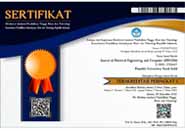Abdul Karim & M Irfan Efendi (2021), PKM Upaya Peningkatan Kompetensi Guru di Masa Pandemik Covid-19 Untuk Menunjang Pembelajaran Berbasis Digital, Jurnal Trilogi, Universitas Nurul Jadid.
Abdul Karim (2022), Upaya Meningkatkan Kemampuan Digitalisasi Kelompok PKK Desa Jabungsisir dengan Sistem Informasi Ulem-Ulem Berbasis Android, Jurnal Guyub, Universitas Nurul Jadid.
Abdul Karim, M Jais Romli, Habibur Rahman, Muhammad Fajar Hariyadi, Moh. Jupri Efendi, Moch. GilangRomadhon, (2024), PKM Pendampingan Pemanfaatan Teknologi Digital dalam Pengelolaan dan Penyimpanan Data, Jurnal Sinar, Kraksaan Probolingo.
Annisa Nur Amalia, A. Jalaludin Sayuti, Yulia Pebrianti, Lidia Desiana, (2022), Analisis Efektivitas Penyediaan Fasilitas Pendukung QR code untuk Menjelaskan Sejarah Benda di Museum & Zoo Tanjungpandan, Belitung, Polsri.
Edson Putra, Christian Haerani, Ryan Sidomulyo, Veren Rondonuwu, Christina Golung, Adam Stenly (2024), Digitalisasi Museum Berbasis Web Dengan AR Dan QR Code (Studi Kasus Pada Museum Sulawesi Utara), Teknik Elektro Dan Komputer Triac, Universitas Trunujoyo Madura.
Haffas Zikri Ariyandi, Anik Nur Handayani, (2022), Peran Penggunaan Teknologi QR Code untuk Meningkatkan Keterhubungan dan Efisiensi Masyarakat Menuju Era Transformasi Society 5.0, Inovasi Teknik dan Edukasi Teknologi, Universitas Negeri Malang.
Hendra Gunawan, ST, M.Eng, (2015) Pemanfaatan Teknologi QR Code Dalam Pengembangan Sistem Pendaftaran Calon Mahasiwa Baru di Universitas Islam Riau, Teknologi Terapan Politeknik Negeri Indramayu.
Leonardus W. Wasono Mihardjo, (2020), Webinar Accelerating Digital Transformation During The Pandemic. https://graduate.binus.ac.id.
Putra, A. R. (2019). Implementasi QR Code dalam sistem absensi berbasis web pada CV. Cahaya Nusantara. Jurnal Teknologi dan Sistem Informasi, 7(2)
Rachmat Suryadithia, Faktor-Faktor yang Mempengaruhi Penggunaan QR Code pada Era Digitalisasi dengan Metode Usability, Paradigma, Universitas Bina Sarana Informatika Bogor.
Rahmawati, N. (2021). Pengembangan sistem informasi absensi mahasiswa menggunakan QR code berbasis web pada Universitas X (Skripsi). Universitas Negeri Yogyakarta.
Yetti Yuniati1, Anisa Ulya Darajat, Ubaidah, Baiqodar, (2024) Pemanfaatan QR-Code untuk Akses Informasi Digital Koleksi Museum Ruwa Jurai Lampung, Abdimas Mandiri, Universitas Indo Global Mandiri.
Yusuf, M., & Wulandari, D. (2020). Digitalisasi proses absensi karyawan menggunakan QR code dan web-based application di PT. XYZ. Jurnal Sistem Informasi dan Informatika, 3(1).
Syahirul Alim, P. P. (2020). Sistem pakar diagnosa penyakit tanaman kakao menggunakan metode certainty factor pada kelompok tani pt olam indonesia (cocoa) cabang lampung. AuthorGuideline_JDMSI, 26-31.
Sulistiyanto S, Imaduddin I, Nadhiroh AY, Widoretno S, Fahmi MH, Mukhlison M, Zuhair A, Pawening RE. IoT-based model for real-time monitoring of new and renewable energy systems. EUREKA: Physics and Engineering. 2025 Mar 31(3):36-48.
Ching-yin law, Simon so. QR Codes in Education, Journal of Educationan Technology Development and Exchange, 3(1), 85-100.
M.Pasca Nugraha, Rinaldi Munir. Pengembangan Aplikasi QR Code Generator dan QR Code Reader dari Data Berbentuk Image, Konferensi Nasional Informatika, Bandung 2011, 148-149.
 (Universitas Nurul Jadid)
(Universitas Nurul Jadid) 








